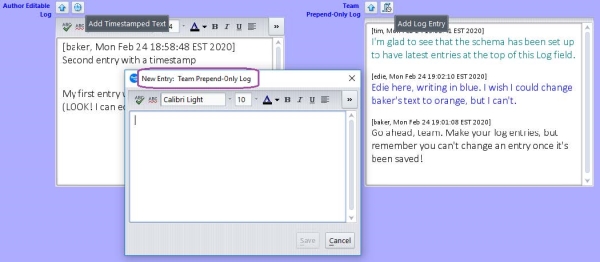Schema Tab
The Schema tab of the Schema Editor contains a table that details all the data fields defined for AccuWork in the current depot.
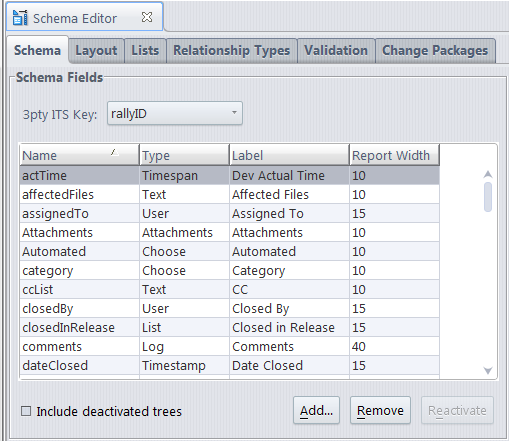
Schema Fields table
If you are not using the repository's default schema, AccuWork initializes the Schema Fields table with two fields.
- issueNum: An integer-valued field that records the position of the issue record in the depot. This number is assigned when a user creates the record (i.e. at the first Save on the Issue form), and it never changes.
- transNum: An integer-valued field that records the transaction number of the most recent update to the issue record. The transaction appears in the depot's transaction log — the same log that records AccuRev transactions, such as keep and promote. The type of the issue-record-update transaction is dispatch.
Notes:
-
issueNum vs. transNum
A record's issueNum value never changes, but its transNum value changes each time a user Save's the record. issueNum and transNum are indexes into two different databases.
-
AccuRev/AccuWork integration
The change package-level integration between AccuRev and AccuWork also updates issue records, and so changes the value of the transNum field. See Change-Package-Level Integration between AccuRev and AccuWork.
Adding Fields to the Schema
You can define any number of additional fields in the schema. Follow these steps for each new field:
- Click the Add button at the bottom of the Schema subtab.
-
Fill in the Create New Field window that appears:

- Name: The official field-name of the field. AccuWork users don't ever need to know this name — they know the field by its label. The field-name must not contain any
SPACEcharacters. Validations must be expressed in terms of the field's name, not its label. - Type: One of the data types supported by AccuWork. See Data Types for more information.
- Label: The field-label character string that identifies the field on the Issue form. A field-label can contain SPACE characters (e.g. Last Name ).
- Report Width: An integer that determines the relative width of the field in the HTML table created when the user clicks Export on the Issue form of an individual issue record.
- Name: The official field-name of the field. AccuWork users don't ever need to know this name — they know the field by its label. The field-name must not contain any
- Click Ok to close the Create New Field window.
-
In the Field Values box to the right of the Schema Fields table, specify additional information about the field. The kind of information required varies with the data type.

Repeat the steps above as often as required to create new fields. Your field definitions are not saved until you click the Save button in the lower-right corner of the Schema Editor tab. You cannot save your work until you place at least one field in the Issue form (Layout subtab).
Each field you define in the Create New Field window must have one of the AccuWork data types listed in the table below.
| Field Type | Possible Values | Required Additional Information in "Field Values" Box |
|---|---|---|
| Text | Any character string. For multiple-line fields, the string can include line-terminators. |
Height: number of lines displayed for the field in the Issue form (default: 1). For multiple-line fields (height > 1), the Issue form includes an expand/contract button to increase/decrease the number of lines displayed. Width: relative width of field in the Issue form. Value Is URL: (available in 7.6.1 and later versions) whether the string is a URL. If selected, the user can open the URL in a browser from the issue form. This checkbox is enabled only if the Height field is empty. Note: Text fields can be configured to support rich text. See Enabling Rich Text for Text and Log Fields for more information. |
| Choose | One of the strings specified in the Field Values box for this field. | A set of strings. In the Issue form, a list-box containing this set of strings is offered to the user. See Defining Multiple-Choice Lists for more information on creating fields that displays lists. |
| Timestamp | An AccuRev timestamp. | Granularity (year, month, day, hour, minute, or second). In the Issue form, the user fills in fields that indicate a time, to the granularity you specify here. |
| User | One of the principal-names in the user registry maintained by the AccuRev server or the display name. | Display Property: designates what user information to display in this field. The list includes <default> (display the AccuRev username) and all custom user properties that have been defined on the system. For example, if Display Name is selected from the list, this field in the issue form will list the display names of users instead of their AccuRev usernames. In the Issue form, a list-box is offered to the user, containing the names of all registered AccuRev users. |
| Group | A group of users related to a specific role. | None. |
| Timespan | A numeric value, indicating a number of hours or days. Non-negative, decimal values (e.g., 4.5) are allowed. |
Calculated by AccuRev: Whether the timespan is (a) calculated by AccuRev as the difference between two timestamp fields, or (b) an editable numeric value. Difference between two timestamp fields: The timestamp fields whose difference in values is the value of the calculated timespan field. If a timestamp field specified here has no value, the current date and time are used in its place for the calculation. Granularity: Hours or days. (Restricted to days for a calculated timespan field.) |
| List | One of the strings specified in the definition of a particular named list. | The name of an existing list, defined on the Lists subtab. In the Issue form, a list-box containing the set of strings defined in the named list is offered to the user. See Defining Multiple-Choice Lists for more information on creating fields that displays lists. |
| Log | Any character string (variant of text field type) |
Height: number of lines displayed for the field in the Issue form (default: 1). For multiple-line fields (height > 1), the Issue form includes an expand/contract button to increase/decrease the number of lines displayed. Width: relative width of field in the Issue form. Enable Rich Text: Log fields can be configured to support rich text. See Enabling Rich Text for Text and Log Fields for more information. Allow Users to Edit Existing Contents of Log: Log fields can be configured so that past log entries can not be changed. For more information, see Read-Only Log Entries in an Issue. Add new text to: Where in the log you want new text entered. Choices are at the beginning or at the end. |
| Attachments | A set of attachment definitions. | Height, Width: the height (number of lines) and width (approximate number of characters) of the edit-form field that lists the attachment definitions. |
| Relationship | A set of issue records. | See Defining Issue Record Relationships andRelationship Types TabRelationship Types Tab for more information. |
| Internal | A positive integer. | None. You cannot create a field with this data type; it is used only by the built-in fields issueNum and transNum . |
Removing a Field / Restoring a Field
To remove an existing field (except for issueNum and transNum), select it and click the Remove button. The field disappears from the Schema tab and can no longer be used in the Issue form. But any data stored in existing issue records is preserved.
When you remove a field from the schema, AccuWork checks whether the field is used in the Issue form. If so, it removes the field from the Issue form
You can restore a removed field to the schema:
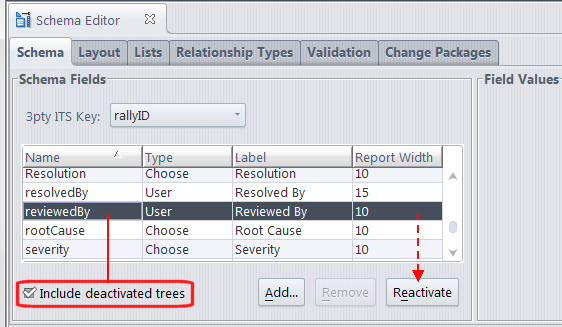
- Check the Include deactivated trees checkbox. All removed fields appear in the list, with a gray background.
- Select the field to be restored, and click the Reactivate button.
Specifying the Lookup Field
The ![]() Issues > Look Up command prompts the user to enter a value, then uses that value to locate an issue record.
Issues > Look Up command prompts the user to enter a value, then uses that value to locate an issue record.
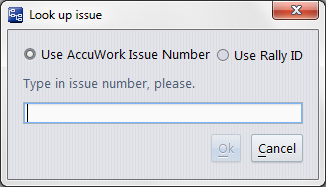
By default, this lookup operation uses the issueNum field (whose user-visible label is Issue).
You can configure another field to be used for issue-record lookups, using the 3pty ITS Key listbox. (This feature is designed to facilitate AccuBridge and AccuSync integrations with third-party issue-tracking systems.)
Select another field from the listbox, and save the schema.

Thereafter, the Issues > Look Up command will prompt for a value to be matched against the specified field.
Notes
-
Value-matching on lookups
The Issues > Look Up command requires an exact match between the user's entry and the value in the issue-record field. Exception: upper-case/lowercase differences are ignored. This can cause problems if the lookup field is a Text field.
-
Uniqueness of lookup values
AccuRev guarantees uniqueness of the issueNum field value only. It allows duplicate values in all other fields. Be sure to specify an alternative lookup field whose values are rendered unique by some other mechanism. If a user performs a lookup on a non-unique value, an error occurs:

Integrating Configuration Management and Issue Management
AccuWork records each promoted version in the issue record, in a special section named Changes. This section is maintained automatically by AccuWork — you don't need to define any fields to enable this change package integration. See Change-Package-Level Integration between AccuRev and AccuWork for more information.
Defining Multiple-Choice Lists
The choose and list data types are similar:
-
For a choose field, the set of possible values — an ordered list of strings — is part of the individual field definition. You enter the possible-values list in the Field Values box for that field.

-
For a list field, the set of possible values is also an ordered list, but it is not part of the individual field definition. In the Field Values box, you specify the name of one of the lists created on the Lists subtab. Any number of list fields in AccuWork (within a single depot) can use the same named list.

The mechanics of defining the ordered list is similar in the "local" case (for an individual choose field) and in the "global" case (on the Lists subtab, for use by any number of list fields). On the Lists subtab, you must supply a ListName for the list; for an individual choose field, the possible-values list doesn't need or have a name.
Defining Issue Record Relationships
When you create a field of type Relationship, you must select the Duplicate, Subtask, or Dependency relationship type for the field. On an Issue form, the field's edit-widget is a pair of tables. The upper table displays "inward" or "child" relationship links — that is, links from other issue records to the current record. The lower table displays "outward" or "parent" relationship links — that is, links to other issue records from the current record. (Multiple-link chains are not allowed — each issue record can be related to others by child links or parent links, but not both.)
The figure below show how a Duplicate relationship field appears in an Issue form. A relationship field of type Subtask or Dependency appears similarly.

Enabling Rich Text for Text and Log Fields
AccuWork supports rich text for fields with data types of Text and Log. Fields for which you wish to enable rich text must have a Height of at least 1.
When you enable rich text for a field, AccuWork:
- Displays tools for working with rich text
- Renders formatted text (and not tagged HTML, for example)
See Rich text fields for more information and examples.
To enable rich text for an AccuWork field:
- Close any open issues.
-
On the Schema tab, select the field for which you want to enable rich text.
Tip: Only fields with a data type of Text or Log support rich text.
-
In the Field Values pane:
- Ensure that the field’s Height is 1 or more.
- Click the Enable Rich Text check box.
- Click the Save button.
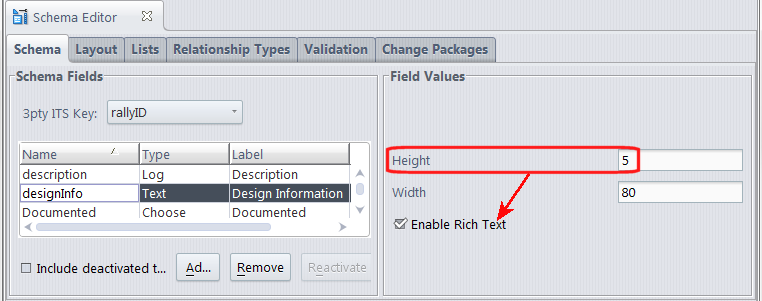
- Close the Schema Editor tab.
Read-Only Log Entries in an Issue
In AccuWork, Log-type schema fields can be configured to prevent users from editing past log entries in the field. To make a Log field’s old entries read-only, uncheck the Allow Users to Edit Existing Contents of Log checkbox for that field in AccuWork’s Schema Editor.
If the checkbox is cleared, the Log field itself is read-only in AccuWork. You can click the log entry icon and type a new log entry into the modal "New Entry" dialog that is displayed. When you click Save in the dialog, your new entry is displayed either prepended or appended (as configured) to the existing log contents in the read-only Log field.
Up until you save the issue, you can click the log entry icon again to modify the log entry that you created earlier. The entry’s contents and timestamp are updated when you click Save in the Edit Entry dialog. Once you save the issue, however, it is no longer possible to edit previous log entries.
Read-only log entries were introduced in AccuRev release 7.4. When a pre-7.4 schema is edited with the Schema Editor in release 7.4 or later, existing Log fields are displayed with the checkbox checked. That is, past entries in those Log fields will continue to be editable unless the administrator manually clears the checkbox and saves the schema.








